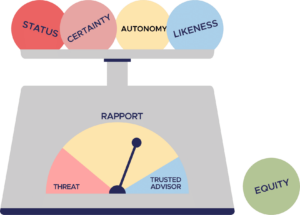Gone are the days of having to memorize scripts for handling specific objections!
Expert salespeople understand what objections amount to and how to use a questioning strategy to allow prospects to achieve the Certainty necessary to move out of their comfort zone.
To effectively manage Resistance, salespeople must have a clear understanding of the prospect’s specific objections. Once a salesperson understands what they are dealing with, these challenges become welcome and have a clear resolution.
Sales professionals shouldn’t be scrambling with different approaches for each and every single objection that the prospect shares.
Rather, they learn how to reduce resistance, no matter what the prospect shares.
Remember that it’s 100% natural to want to resist whatever a salesperson is saying or offering you.
It’s a human emotion and the most effective way to work with this natural emotion is to maintain S.C.A.L.E. through the AAA framework.
Let’s quickly review the S.C.A.L.E. and then introduce you to the AAA framework

S.C.A.L.E.
S.C.A.L.E. stands for Status, Certainty, Autonomy, Likeness, and Equity.
When you master how to create and monitor rapport through S.C.A.L.E., then you’ll be much more likely to detect which deals are moving forward vs. stuck in your pipeline.
And when resistance (commonly known as objections) arises, the best way to respond while maintaining rapport is to use the AAA framework.



